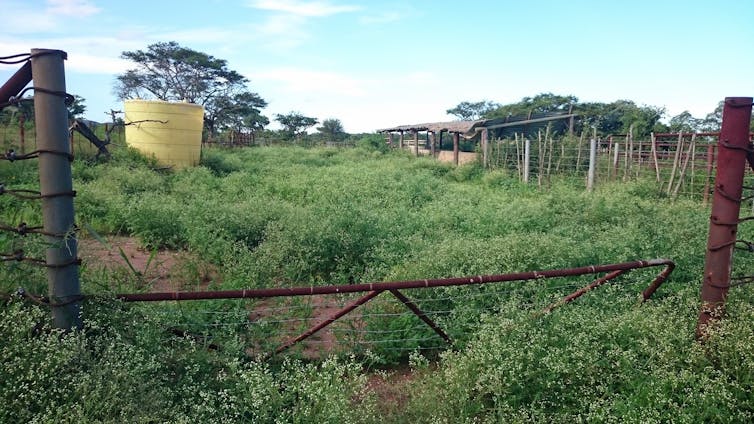Keeping famine weed at bay
- Blair Cowie
A leaf-feeding beetle is one of the most promising agents that help South Africa to control the spread of its worst invader plant.
The poisonous herb, Parthenium hysterophorus, is one of the world’s most destructive invasive plants. It threatens biodiversity, national food security and human health. Native to parts of Central and South America (Gulf of Mexico) it has spread to more than 40 countries including Australia, India, Pakistan, Ethiopia, Swaziland and South Africa. In South Africa it’s known as famine weed.
Much of southern and eastern Africa remains susceptible to famine weed invasion. First recorded in South Africa in 1880, famine weed only became a prominent invader in 1984 after cyclone Demoina hit the country. Since then, the plant has rampantly invaded northern and eastern parts of the country prompting major concern.
Famine weed spreads rapidly and is devastatingly destructive. It kills other plants within its vicinity, wipes out entire crop harvests, poisons wildlife as well as livestock, makes food inedible and causes a variety of health problems in humans.
Controlling famine weed is incredibly difficult, but it is possible. A number of approaches have been trialled and include physical and mechanical removal, herbicide sprays, prescribed fires and biocontrol (using the weed’s natural enemies).
So far South Africa is mainly attempting to thwart the spread of famine weed and reduce infestations using biocontrol. Rather than trying to get rid of the weed entirely, biocontrol uses Parthenium’s natural enemies to slow down infestation and spread of the weed. Following biocontrol successes in Australia and India, South Africa become the first African country to implement biocontrol against Parthenium in 2003.
The use of biocontrol in South Africa has made some progress in slowing the spread of famine weed, but the battle is never ending.
Devastating effects
The weed’s rapid growth rate and prolific seed production make it highly troublesome. It’s tiny seeds are easily spread by wind, water, animals, vehicles, or in soil, and can remain viable for up to 10 years. Once germinated, famine weed out-competes and chemically excludes surrounding vegetation in a process known as allelopathy, decimating an areas biodiversity.

Famine weed is also toxic to wild game and domestic livestock. It causes ulcers of the mouth, skin lesions and even death if consumed in large amounts. Milk and meat from livestock reared on fields or fodder infested with famine weed are unfit for human consumption.
From an agricultural perspective, the weed lessens the grazing capacity of rangelands (pastures). It also degrades and removes hectares of arable land, costing millions of rand in losses. If uncontrolled, it has the potential to reduce crop yields by as much as 97%. Similarly, crop harvests contaminated with famine weed suffer massive reductions in their value. In severe cases, entire harvests become unusable.
The weed and its pollen also pose numerous health threats to humans. These include asthma, bronchitis and hay fever but also skin problems like dermatitis, rashes and blisters.
Controlling famine weed
Physically removing the weed can work for extremely small infestations but only if the root is removed before the plant sets seed. Mechanical clearing like mowing or slashing is not recommended, as this accidentally spreads seeds and furthers the weed’s invasion.
Herbicides work, but only if proper follow-ups are made to kill new plants. And intensive chemical control may not be suitable for agricultural areas or grazing lands. The high cost of herbicides also makes it unfeasible for areas with low commercial value or in poorer communities.
Prescribed fires may hold promise in reducing Parthenium seedbanks, but research into the effects of burning remains preliminary and hotly debated.
Biocontrol is one of the most promising and cost-effective solutions to successfully manage infestations. It allows scientists to make use of a weed’s natural enemies to effectively and “naturally” manage the problem species. Since the initiation of biocontrol efforts in South Africa the country has released four biocontrol agents: a leaf-rust fungus (Puccinia xanthii), a stem-boring weevil (Listronotus setosipennis), a leaf-feeding beetle (Zygogramma bicolorata) and a seed-feeding weevil (Smicronyx lutulentus).
All of these agents exert different levels of damage to famine weed populations in the field. Researchers hope that the damage inflicted will steadily increase over time and offer greater control, particularly by the leaf-feeding beetle and the stem-boring weevil. Additional agents are also under investigation.

Slowing the spread of famine weed
Prevention is ultimately better than cure. Landowners should familiarise themselves with the weed and remain vigilant. For landowners facing famine weed invasion, every effort should be made to reduce the density and contain spread of the weed. Good land management practices, particularly maintaining good grass cover, are critical to preventing and reducing famine weed invasion. Sowing bare overgrazed soil patches with native grass seed may aid in restoring grass coverage and limiting infestation.
![]() Biocontrol alone is unlikely to completely control famine weed at present. But in the interim, researchers have come up with a specially catered national strategy to optimise Parthenium control. This strategy aims at implementing the best control options throughout different parts of South Africa.
Biocontrol alone is unlikely to completely control famine weed at present. But in the interim, researchers have come up with a specially catered national strategy to optimise Parthenium control. This strategy aims at implementing the best control options throughout different parts of South Africa.
Blair Cowie, PhD Candidate Invasive Species Management, University of the Witwatersrand. This article was originally published on The Conversation. Read the original article.

